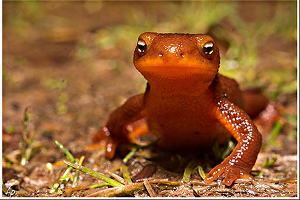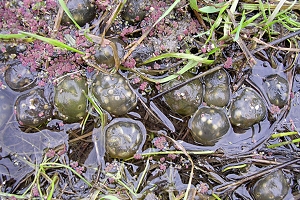 Rough-skinned newt. Photo: ap.
Rough-skinned newt. Photo: ap.
The newts are on the move again. Each fall, after the rains start, the newts of Berkeley’s Tilden Park start migrating from the woods to waters of Wildcat Creek, where they mate and lay their eggs. South Park Drive, popular with cyclists and Sunday drivers, crosses their migratory path. Each year from November 1 to April 1 the road is closed to cars, to prevent the newts from getting squished. (How did the newt cross the road? Not by being run over, that’s for sure.)
The newts in question are the California newt, Taricha torosa, brown with a yellow/orange belly, and the rough-skinned newt, Taricha granulosa, which also has an orange belly and, as its name suggests, has rough, brown skin. The newts’ orange bellies are warning signs to predators—both species produce tetrodotoxin, a powerful neurotoxin. However, the rough-skinned newt’s toxin is ten times more powerful than the California newt’s toxin.
 Newts lay egg masses, like these, in ponds and slow-flowing streams. Photo: Jennifer Skene.While these two species are not technically threatened, their habitat has been impacted in recent years: their forests and fields have become our neighborhoods, roads have chopped their remaining habitat into fragments, and the streams and ponds where they lay their eggs have been degraded. The least we can do at this point is refrain from running them over!
Newts lay egg masses, like these, in ponds and slow-flowing streams. Photo: Jennifer Skene.While these two species are not technically threatened, their habitat has been impacted in recent years: their forests and fields have become our neighborhoods, roads have chopped their remaining habitat into fragments, and the streams and ponds where they lay their eggs have been degraded. The least we can do at this point is refrain from running them over!
